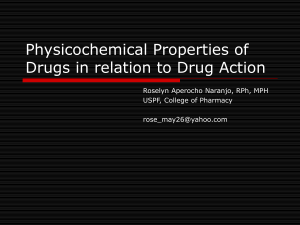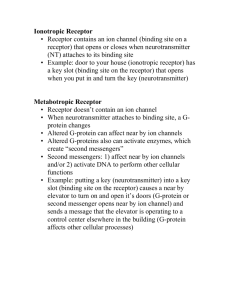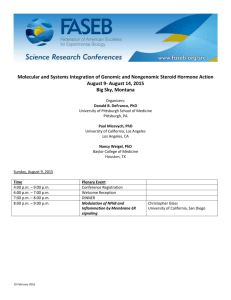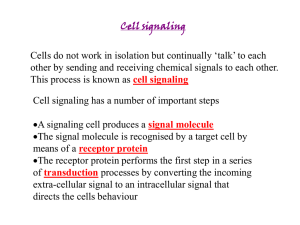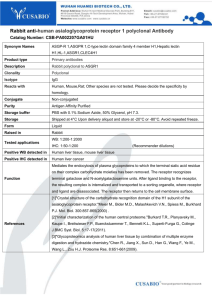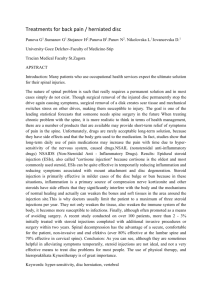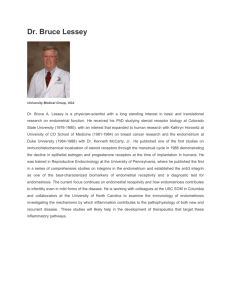BS2550 Lecture Notes Steroids
advertisement
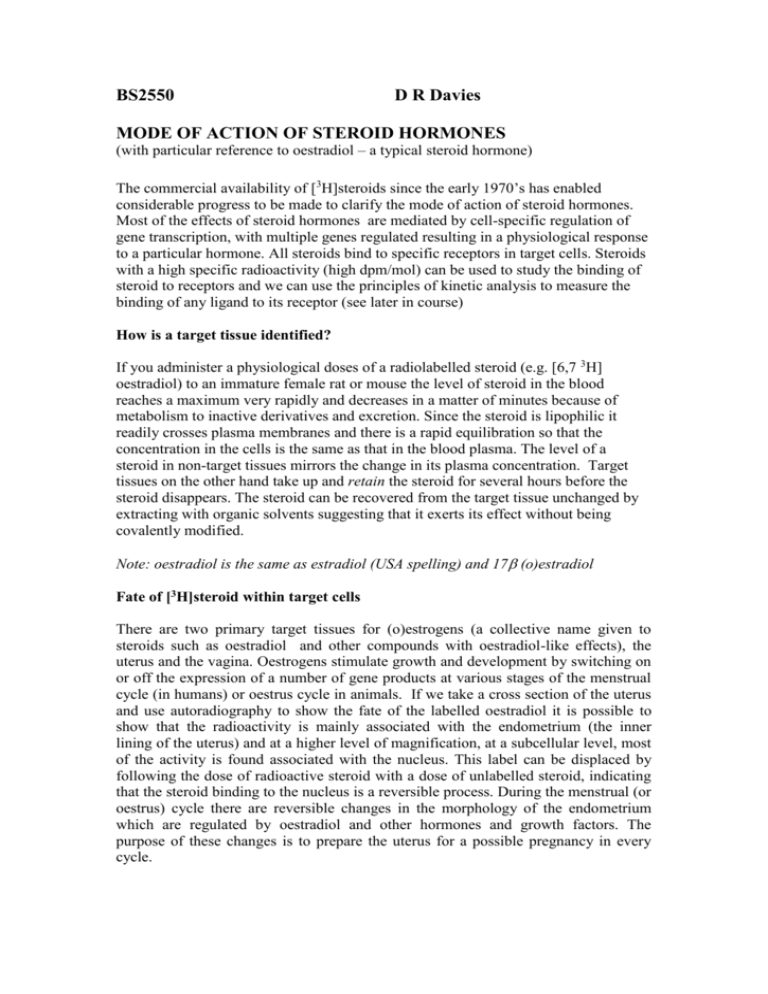
BS2550
D R Davies
MODE OF ACTION OF STEROID HORMONES
(with particular reference to oestradiol – a typical steroid hormone)
The commercial availability of [3H]steroids since the early 1970’s has enabled
considerable progress to be made to clarify the mode of action of steroid hormones.
Most of the effects of steroid hormones are mediated by cell-specific regulation of
gene transcription, with multiple genes regulated resulting in a physiological response
to a particular hormone. All steroids bind to specific receptors in target cells. Steroids
with a high specific radioactivity (high dpm/mol) can be used to study the binding of
steroid to receptors and we can use the principles of kinetic analysis to measure the
binding of any ligand to its receptor (see later in course)
How is a target tissue identified?
If you administer a physiological doses of a radiolabelled steroid (e.g. [6,7 3H]
oestradiol) to an immature female rat or mouse the level of steroid in the blood
reaches a maximum very rapidly and decreases in a matter of minutes because of
metabolism to inactive derivatives and excretion. Since the steroid is lipophilic it
readily crosses plasma membranes and there is a rapid equilibration so that the
concentration in the cells is the same as that in the blood plasma. The level of a
steroid in non-target tissues mirrors the change in its plasma concentration. Target
tissues on the other hand take up and retain the steroid for several hours before the
steroid disappears. The steroid can be recovered from the target tissue unchanged by
extracting with organic solvents suggesting that it exerts its effect without being
covalently modified.
Note: oestradiol is the same as estradiol (USA spelling) and 17 (o)estradiol
Fate of [3H]steroid within target cells
There are two primary target tissues for (o)estrogens (a collective name given to
steroids such as oestradiol and other compounds with oestradiol-like effects), the
uterus and the vagina. Oestrogens stimulate growth and development by switching on
or off the expression of a number of gene products at various stages of the menstrual
cycle (in humans) or oestrus cycle in animals. If we take a cross section of the uterus
and use autoradiography to show the fate of the labelled oestradiol it is possible to
show that the radioactivity is mainly associated with the endometrium (the inner
lining of the uterus) and at a higher level of magnification, at a subcellular level, most
of the activity is found associated with the nucleus. This label can be displaced by
following the dose of radioactive steroid with a dose of unlabelled steroid, indicating
that the steroid binding to the nucleus is a reversible process. During the menstrual (or
oestrus) cycle there are reversible changes in the morphology of the endometrium
which are regulated by oestradiol and other hormones and growth factors. The
purpose of these changes is to prepare the uterus for a possible pregnancy in every
cycle.
The Binding of [3H] steroid to Steroid Receptor (SR)
When oestradiol (or any steroid) enters the target cell it binds to a so-called ‘soluble’
receptor associated with the cytoplasm or nucleoplasm. The SR complex formed
undergoes a transformation process and then becomes associated with the nucleus in a
tightly- bound form. In the initial studies of SR, labelled steroid was incubated with
protein fractions from cells and the bound and unbound steroid were separated by
sucrose density gradient (linear gradient 5%-20% sucrose) centrifugation for many
hours. The receptor-bound steroid migrates through the gradient while the unbound
steroid remains at the top of the gradient. The rate of migration (Sedimentation
Coefficient or S value ) depends on a number of factors including the Molecular Wt,
shape and density of the receptor and in general the size of the receptor complex is
related to the S value but not in a linear fashion.
Oestradiol binding in the uterus
If you make extracts of uterus with a low salt (50 mM KCl) buffer and examine the
binding kinetics by Scatchard analysis it is possible to resolve two classes of binding
site
Type I: a high affinity site with a KD in the range 2 x 10-10 to 1 x 10-9 M. There is a
limited concentration of these receptor sites estimated at about 16,000 receptor
molecules per cell (a concentration of about 10 nM)
Type II: a low affinity site with a KD of about 1 x 10-7 M but present at a much higher
concentration. The function of Type II is not known but there does appear to be a
correlation between the occurrence of this receptor and the oestrogen-sensitivity of
the tissue.
However in these lectures are concerned with the high affinity Type I receptor site.
If a cytosolic fraction is incubated with [3H] oestradiol and then the mixture is
subjected to sucrose density gradient centrifugation, the receptor sediments with a
coefficient of 9S. On the other hand if an extract is made with a high salt (400 mM
KCl) buffer the receptor sediments at a slower rate, the 4S form. This indicates that
the 9S form is a complex consisting of a number of different sub-units, whilst the 4S
form turned out to be the monomeric form of the receptor. There is also a 5S form,
which can be extracted with high salt from uterine nuclei which was revealed to be a
dimer. In the early work on receptor proteins these forms were referred to by their S
values.
Oestradiol Receptor Complex (steroid hormone receptor complexes in general)
The 9S oestradiol receptor complex consists of a number of different proteins which
appear to be essential for its activity and there are number of accessory proteins which
appear to be essential for the assembly of this complex.
The 9S complex consists of the following:
The receptor monomer itself ( 66 Kda)
Two molecules of a heat shock protein hsp90 (90 Kda) – a chaperone protein*
P23 (23Kda) also a chaperone protein
An immunophilin (FKB51) which has peptidyl prolyl isomerase activity and may
be involved in protein folding
An inactive precursor complex also has the following:
One molecule of another heat shock protein (hsp70) (70Kda) –also a chaperone
A hsp40 (40Kda) which is a cofactor for hsp70
HOP (60Kda) which is a scaffolding protein – an assembly factor for hsp70 and
hsp90
HiP (p48) (48 Kda) –also a hsp70 cofactor
The 9S complex therefore has a Molecular Weight of > 300 Kda, and in the absence
of hormone, is found in the cytoplasm (or possibly nucleoplasm) of the cell. The
receptor protein will not bind DNA in this form. Similar complexes are found
associated with other Steroid Receptors. (for Diagram see handout entitled Activation
of Steroid Hormone Receptors)
Note: {* hsp90 is an ubiquitous, abundant, essential and highly conserved protein
which performs a general molecular chaperone function in cells. In this system it
maintains the Steroid Receptor in the high affinity, ligand binding conformation and
prevents nuclear binding of the receptor}
Transformation of the 4S 5S form
Nuclear retention of the high affinity receptor is essential for the effects of oestradiol
on uterine developmental changes. Since the receptor associated with the DNA in the
nucleus is 5S and the monomer extracted from the cytoplasm is 4S it is clear that
some event must have occurred which results in strong nuclear binding. The free 4S
receptor is also much more labile than either the 9S complex or the 5S form
When the steroid binds to the 9S form a conformational change occurs resulting in the
release of the 4S monomer which then undergoes dimerization to the 5S form. The 5S
homodimer has an increased affinity for oestradiol and is also capable of binding with
high affinity to DNA. This transformation is dependent on oestradiol, the cytosolic
proteins and the salt concentration and is temperature-sensitive implying a protein
catalysed conformational change in the receptor protein:
9S
complex
4S
monomer
5S
dimer
the appearance of the 5S form in the nucleus is always accompanied by the loss of the
4S monomer from the cytoplasm. The 5S form can be dissociated into the 66 Kda
monomer by dialysis against 0.5 M sodium thiocyanate.
Regulation of Gene Transcription
The consequence of oestradiol binding to the transformed receptor in the nucleus
results in the induction or repression of the transcription of specific genes. This can be
shown by the incubation of uterine tissue with [35S] methionine in the presence or
absence of oestradiol and then extracting the total protein and subjecting it to
separation on 2 Dimensional IEF/SDS gels and then subjecting the gels to
autoradiography. It is then clear that a number of proteins are induced or repressed
when the control and oestrogen treated cells are compared.
More information on the oestrogen receptor monomer
Steroid receptors belong to the same family of proteins, have a very similar structure
and share many properties. The have a similar domain structure as follows:
N
C
A
B
C D
E
F
A and B are highly variable between different steroid receptors but contain sites
which can modulate transcriptional activation e.g. protein kinas phosphorylation
motifs
C is a 66 aminoacid highly conserved sequence involved in binding to the Hormone
Response Element (HRE –see below) and also in the dimerization of rhe receptor.
D is a hinge region very susceptible to proteolysis contributing to the instability of the
receptor. This region also contains a nuclear localization site
E is the steroid binding domain and is also involved in the dimerization
F is the C –terminal domain and has no known function.
Many steroid receptors have now been cloned and sequenced. In order to ascribe
functions to the various domains, deletion mutants have been produced lacking
particular sequences, the corresponding cDNA transfected into HeLa cells and
oestrogen-inducible gene transcription measured after gene transcription.
Hormone Response Elements (HRE) or ERE (Oestrogen Response Elements)
GRE (Glucocorticoid Response Elements) etc.
There is a hormone response element located upstream (up to several hundred base
pairs upstream) of the transcription start site of all hormone responsive genes where
the promoter region has been sequenced. This is the site at which the hormone
receptor dimeric complex binds specifically to DNA.This HRE is identified by a
DNAase footprinting technique where the receptor is allowed to bind to the DNA and
thus protects a particular sequence from the action of DNAase. When these sequences
have been characterized they are found to consist of a palindromic sequence of bases
which read the same from the 5’ to 3’ as they do on the opposing strand of DNA.
These notes are intended to be used in conjunction with Lecture Handouts and
appropriate chapters in textbooks (e.g Molecular Cell Biology, Lodish et al. 4th
edition, Chapter 20, Cell-to Cell Signalling: Hormones and Receptors; Biochemistry
with Clinical Correlations, Devlin TM . 4th edition, Chapt 21, Biochemistry of
Steroid Hormones which show chemical structures and have excellent diagrams
illustrating most of the points made in these lecture notes.
